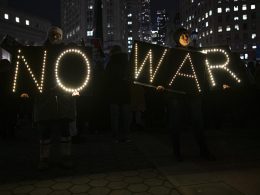Only one year ago, the Occupy Wall Street movement began its encampment of Zucotti Park in New York City. A mere two weeks later, the movement exploded to hundreds of cities in every state across the U.S., spreading the struggle against massive wealth inequality in society.
A year later, despite the movement’s decline, it transformed consciousness among the broad mass of workers and young people. It brought tens of thousands into action, many for the first time, giving them a taste of their collective power.
Many lessons can be learned from the movement, from both its successes and its later decline. And though Occupy today isn’t a mass force in the streets, its early days last year foreshadowed the even bigger struggles that will emerge in the near future.
The Beginnings
Occupy Wall Street began as a small protest of a few hundred young people, who began an occupation a few blocks from Wall Street. It rapidly attracted the attention and support of many in New York and all over the U.S. The main message was simple, yet effective: The 1%, the super-rich who control the vast majority of wealth – and with it economic, social and political power – were getting even richer at the expense of the vast majority, the 99%.
This message resonated with workers and young people who had been battered by budget cuts, foreclosures, unemployment, and tuition hikes. It spoke to the brutal reality facing working people under the Great Recession and U.S. capitalism’s crisis.
Attraction to Occupy’s message quickly translated into active support. Unions mobilized thousands of their members to Occupy Wall Street marches. After heavy-handed police repression, such as mass arrests and pepper-spraying of protesters, was broadcast to millions through YouTube videos, occupations sprouted up in several hundred cities, both in the U.S. and globally. After initially ignoring the movement, the corporate media was forced to cover what had become a mass force in society.
What most strikingly demonstrated the power of mass movements in changing consciousness was the effect that Occupy had in changing the political debate in the U.S.
Response to 1% Politicians
At the end of 2010, the Tea Party and Republicans rode into office on a wave of disillusionment with Obama and the Democratic majority in both Houses of Congress.
Emboldened by this victory, Tea Party politicians blamed public sector workers and unions for the economic crisis and the budget deficits facing state governments. Democrats, who when in power were no better, considering they also attacked state workers and social programs, put up little resistance. Under this right-wing ideological onslaught, which was essentially unchallenged by the Democrats and corporate media, public sector workers became the scapegoats.
Nobody epitomized this more than Wisconsin Governor Scott Walker. He led the charge in trying to not only to attack public sector unions, but to smash them outright. In February 2011, Walker proposed legislation to strip collective bargaining rights from teachers and other state workers.
This unleashed a tidal wave of protests and a month-long occupation of the state Capitol. Walker was only able to ram his rotten bill through the Republican-controlled legislature after union leaders demobilized the struggle. Walker’s victory emboldened other Republican governors in Ohio, Michigan and Indiana to push through similar legislation.
The Tea Party/right-wing message that public sector workers and unions were to blame persisted unchallenged – until the emergence of Occupy. Occupy rapidly relegated this reactionary scapegoating to the trash heap. The blame was squarely placed where it belongs: on the Wall Street banksters and the billionaire investors who caused the crisis. Occupy was also able to mobilize into its ranks a number of union members, who saw little defense put up by their own leaders, and to organize successful actions like the Oakland general strike in November and the West Coast port shutdown in December.
The movement also earned massive public support. In numerous polls, a large majority of the public agreed with the movement’s message. And the hundreds of encampments in parks and city halls were a visible daily reminder that the super rich were getting even richer off of all of us.
Weakness and Decline
Unfortunately, Occupy also had weaknesses that helped lead to its decline. Many in the movement rejected having demands and statements of what it stood for. So, other than the overall message of “We Are the 99%,” the movement didn’t publicly demand an end to budget cuts or wars, or taxing Wall Street and the rich.
Despite the movement’s enormous public support, the number of people actively involved in it was relatively small. Tens of millions passively supported it, but only around tens of thousands regularly came out to its marches, encampments and general assemblies.
Having clear demands that spoke to the daily struggles of working people and youth would’ve helped mobilize more into action. But having a plan of action for the struggle would have also drawn more into the movement.
Occupy became overly focused on maintaining the protest encampments in the face of threats and attempts to disperse them from police and politicians. The struggle came to revolve around the occupations as an example of the type of society the movement wanted to build. Many activists thought that these could become examples that would be emulated, transforming capitalist exploitation into a more egalitarian society. But this insular vision, after not attracting mass numbers in defense of the occupations, was in most cases violently dispersed by the forces of the capitalist state.
Rather than calling on the public to join their model microcosm of a better society, Occupy could have better marshaled people into action by organizing an escalating series of actions around a clear set of demands. For example, during the height of the movement actions were organized protesting the big banks, which included occupying and shutting them down. But most of these protests were symbolic, one-off events, with no demands being put on the banks.
These actions – and the movement as a whole – could have more effectively drawn supporters into the struggle by placing a set of demands on the banks at the initial actions. Halting foreclosures, paying proper taxes, or ending executive bonuses are a few examples. If – and most likely, when – the banks didn’t meet those demands, the movement could have then organized a series of escalating public actions until the banks gave in.
Publicly calling attention to the intransigence of banks, exploitative corporations, or politicians in ignoring the movement’s demands and continuing their unjust activities can often spring more people into action. Winning victories, making our target buckle and meet some of our demands, can have the same effect. It shows that organized, mass pressure has the power to force change.
Lasting Imprint
Despite Occupy having declined as an active, mass movement, it has left a lasting imprint on U.S. consciousness. Tens of millions now recognize that they’re being exploited by corporate America and the rich. This will lay the foundations on which future mass movements will be built.
Occupy also trained tens of thousands of activists in the heat of struggle. Many of these activists will question why the movement wasn’t able to force fundamental change. They will learn from their experience and be at the forefront of building future struggles.
Even now, Occupy hasn’t completely disappeared. Sections have reorganized around specific attacks: the Occupy Homes movement against foreclosures in Minneapolis and other cities, for example. This campaign has successfully prevented several families from being kicked out of their homes by the banks. It provides an excellent model of the targeted demands and actions that can achieve the victories necessary to increase the power of the movement and draw more people in.
Likewise, student movements are emerging across the country against tuition hikes and student debt.
Fundamentally, the conditions that gave rise to Occupy haven’t gone away. U.S. capitalism is still in crisis and will be for some time. The living standards of working and young people will continually be under attack. If the economy moves back into recession, these attacks will only intensify. These assaults will again provoke outbreaks of mass struggle in the near future.












